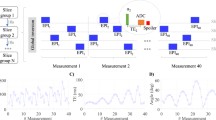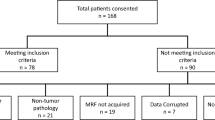Abstract
The purpose of our study is to investigate the feasibility of automated patient verification using multi-planar reconstruction (MPR) images generated from three-dimensional magnetic resonance (MR) imaging of the brain. Several anatomy-related MPR images generated from three-dimensional fast scout scan of each MR examination were used as biological fingerprint images in this study. The database of this study consisted of 730 temporal pairs of MR examination of the brain. We calculated the correlation value between current and prior biological fingerprint images of the same patient and also all combinations of two images for different patients to evaluate the effectiveness of our method for patient verification. The best performance of our system were as follows: a half-total error rate of 1.59 % with a false acceptance rate of 0.023 % and a false rejection rate of 3.15 %, an equal error rate of 1.37 %, and a rank-one identification rate of 98.6 %. Our method makes it possible to verify the identity of the patient using only some existing medical images without the addition of incidental equipment. Also, our method will contribute to patient misidentification error management caused by human errors.






Similar content being viewed by others
References
Asadpour V, Towhidkhah F, Homayounpour MM (2006) Performance enhancement for audio-visual speaker identification using dynamic facial muscle model. Med Biol Eng Comput 44:919–930
Bennardello F, Fidone C, Cabibbo S et al (2009) Use of an identification system based on biometric data for patients requiring transfusions guarantees transfusion safety and traceability. Blood Transfus 7:193–203
Bittle MJ, Charache P, Wassilchalk DM (2007) Registration-associated patient misidentification in an academic medical center: causes and corrections. Jt Comm J Qual Patient Saf 33:25–33
Chen T, Zhan Y, Zhang S, Dewan M (2011) Automatic alignment of brain MR scout scans using data-adaptive multi-structural model. In: Gabor F, Anne M, Terry P (eds) Medical image computing and computer-assisted intervention—MICCAI 2011. Springer, Berlin, pp 574–581
Committee WB, Council NR (2010) Biometric recognition: challenges and opportunities. National Academies Press, Washington, DC
Danaher LA, Howells J, Holmes P, Scally P (2011) Is it possible to eliminate patient identification errors in medical imaging? J Am Coll Radiol 8:568–574
Dunn EJ, Moga PJ (2010) Patient misidentification in laboratory medicine a qualitative analysis of 227 root cause analysis reports in the veterans health administration. Arch Pathol Lab Med 134:244–255
Dunstone T, Yager N (eds) (2009) An introduction to biometric data analysis. In: Biometric system and data analysis. Springer, Boston, pp 3–26
Henneman P (2010) Patient Identification errors are common in a simulated setting. Ann Emerg Med 55:503–509
Kohn Linda T, Corrigan Janet M, Donaldson Molla S (2000) To err is human: building a safer health system. National Academy Press, Washington, DC
Kumari P, Vaish A (2015) Brainwave based user identification system: a pilot study in robotics environment. Robot Auton Syst 65:15–23
Mahalanobis PC (1936) On the generalized distance in statistics. Proc Natl Inst Sci India 2:49–55
Morishita J, Katsuragawa S, Kondo K, Doi K (2001) An automated patient recognition method based on an image-matching technique using previous chest radiographs in the picture archiving and communication system environment. Med Phys 28:1093–1097
Morishita J, Katsuragawa S, Sasaki Y, Doi K (2004) Potential usefulness of biological fingerprints in chest radiographs for automated patient recognition and identification. Acad Radiol 11:309–315
Morishita J, Watanabe H, Katsuragawa S et al (2005) Investigation of misfiled cases in the PACS environment and a solution to prevent filing errors for chest radiographs. Acad Radiol 12:97–103
Odinaka I, Lai P, Kaplan AD, O’Sullivan JA, Sirevaag EJ, Rohrbaugh JW (2012) ECG biometric recognition: a comparative analysis. IEEE Trans Inf Forensics Secur 7:1812–1824
Pagliaro P, Turdo R, Capuzzo E (2009) Patients’ positive identification systems. Blood Transfu 7:313–318
Schulmeister L (2008) Patient misidentification in oncology care. Clin J Oncol Nurs 12:495–498
Shamir L (2013) MRI-based knee image for personal identification. Int J Biom 5:113–125
Shamir L, Ling S, Rahimi S, Ferrucci L, Goldberg IG (2009) Biometric identification using knee X-rays. Int J Biom 1:365–370
Snyder ML, Carter A, Jenkins K, Fantz CR (2010) Patient misidentifications caused by errors in standard bar code technology. Clin Chem 56:1554–1560
Toge R, Morishita J, Sasaki Y, Doi K (2013) Computerized image-searching method for finding correct patients for misfiled chest radiographs in a PACS server by use of biological fingerprints. Radiol Phys Technol 6:437–443
Tsuru K, Pfurtscheller G (2012) Brainwave biometrics: a new feature extraction approach with the cepstral analysis method. Trans Jan Soc Med Biol Eng 50:162–167
van der Kouwe AJW, Benner T, Fischl B et al (2005) On-line automatic slice positioning for brain MR imaging. Neuroimage 27:222–230
Verma N, Rana M (2013) Biometric identification of person using ECG signal. J Chem Biol Phys Sci 4:509–515
Acknowledgments
The authors wish to thank Mr. Steven Gardner for his helpful advice and for improving our manuscript.
Author information
Authors and Affiliations
Corresponding author
Rights and permissions
About this article
Cite this article
Ueda, Y., Morishita, J., Kudomi, S. et al. Usefulness of biological fingerprint in magnetic resonance imaging for patient verification. Med Biol Eng Comput 54, 1341–1351 (2016). https://doi.org/10.1007/s11517-015-1380-x
Received:
Accepted:
Published:
Issue Date:
DOI: https://doi.org/10.1007/s11517-015-1380-x




